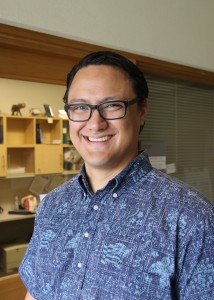
Dutkoski (l) and Bautista with their posters
Research posters featuring the work of two University of Hawaiʻi-West Oʻahu students were among the 33 featured during an undergraduate research conference at the University of Tennessee earlier this month.
UH West Oʻahu students Alexander Bautista and Morgan Dutkoski presented their posters during the 9th Annual Undergraduate Research Conference at the Interface of Biology and Mathematics, which took place in Knoxville, Tenn., Nov. 11 and 12. The duo were accompanied by Dr. Kamuela Yong, an assistant professor of mathematics, who served as the faculty mentor for both students’ research projects.
The conference gives students an opportunity research involving biology and mathematics, with posters being hung for attendees to examine during the event. The conference was hosted by the National Institute for Mathematical and Biological Synthesis (NIMBioS) which brings together researchers in math and biology from across the world. Housed on the campus of the University of Tennessee-Knoxville, NIMBioS is sponsored by the National Science Foundation, departments of Homeland Security and Agriculture with additional support from the university.

Assistant Professor of Mathematics Kamuela Yong
Students hanging posters included those from the University of California Los Angeles, University of Notre Dame, Fisk University, Cornell University, University of Tennessee at Chattanooga, and North Carolina State University. Bautista and Dutkoski presented the results of research done in the summer of 2017 as part of the Kikaha Undergraduate Research Program. The abstracts for their posters were:
Bautista: A Mathematical Model for the Potential of a Zika Outbreak in Oʻahu
The Zika Virus (ZIKV) is an arbovirus that is known to cause flu/cold-like symptoms and microcephaly, a birth defect where the primary characteristic is the child being born with a smaller than average head. This is caused by an improper development of a child’s brain. ZIKV is especially dangerous in the ability for it to not only be passed along during sexual contact, but primarily for its ability to pass along through Aedes mosquitoes. Should an uninfected mosquito bite an infected human, they can proceed to infect other humans a small time after the initial bite. This study intends to explore the potential ability for an outbreak in the island of Oʻahu. Oʻahu is the central island in the state of Hawaiʻi, also known to be the social hub and primary tourist destination of the islands. Being the home of the Aedes albopictus mosquito and just under one million humans, this densely packed island could potentially be a perfect breeding ground for the ZIKV virus. In this study, we will investigate the likelihood of an outbreak in the island of Oʻahu, as well as the parameters in which an outbreak could be possible.
Dutkoski: A Mathematical Model of the 2015 Dengue Outbreak on the Island of Hawaiʻi
The dengue virus is estimated to affect 50 million people yearly worldwide. The dengue virus is not endemic in the state of Hawaiʻi. In the 2015-2016 dengue outbreak on Hawaiʻi Island, 264 confirmed cases of the vector-borne disease were reported to the Hawaiʻi Department of Health. This outbreak was transmitted through the vector species Aedes albopictus and Aedes aegypti mosquitoes, which are endemic to certain areas on the Hawaiʻi Island. With the heavily trafficked tourist destination of the Hawaiian Islands, habit ranges for Aedes albopictus and Aedes aegypti may expand, resulting in a far more serious epidemic than the 2015-2016 outbreak or possibly dengue becoming endemic and establishing itself in Hawaiʻi. In this project, we develop a mathematical model to describe the spread of dengue using a system of differential equations. This model should be able to predict the conditions that would enable dengue to become endemic or have another outbreak in Hawaiʻi.
Yong said both students plan to submit their projects for publication by a peer-reviewed publication this winter. Bautista and Dutkoski will be graduating in December, and plan to seek PhDs in applied mathematics, Yong said.
In October, three UH West Oʻahu students won an Undergraduate Student Poster Presentation Award in Mathematics (general) at 2017 SACNAS — The National Diversity in STEM Conference in Salt Lake City.
